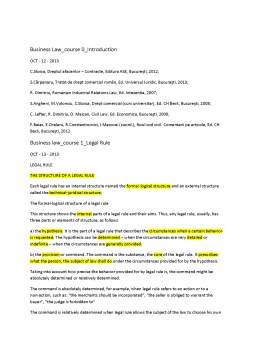Extras din curs
LEGAL RULE
THE STRUCTURE OF A LEGAL RULE
Each legal rule has an internal structure named the formal-logical structure and an external structure
called the technical-juridical structure.
The formal-logical structure of a legal rule
This structure shows the internal parts of a legal rule and their aims. Thus, any legal rule, usually, has
three parts or elements of structure, as follows:
a) the hypothesis. It is the part of a legal rule that describes the circumstances when a certain behavior
is requested. The hypothesis can be determined – when the circumstances are very detailed or
indefinite – when the circumstances are generally provided.
b) the provision or command. The command is the substance, the core of the legal rule. It prescribes
what the person, the subject of law shall do under the circumstances provided for by the hypothesis.
Taking into account how precise the behavior provided for by legal rule is, the command might be
absolutely determined or relatively determined.
The command is absolutely determined, for example, when legal rule refers to an action or to a
non-action, such as: “the merchants should be incorporated”, “the seller is obliged to warrant the
buyer”, “the judge is forbidden to”
The command is relatively determined when legal rule allows the subject of the law to choose his own
behavior, such as: “the owner may take any appropriate decisions”.
c) the sanction – It is a part of a legal rule that specifies whose are the consequences in case of the
non-observance of the rule’s command.
It means that this part of the internal structure of a legal rule specifies the penalties the judge can take
against those who do not comply with the rule’s command. According to the determination rank the
penalty can be:
- absolutely determined – in this case the judge cannot modify it. For example the nullity of a contract;
- relatively determined – in this case, law provides for a minimum and a maximum limit of the penalty
and the judge might choose the concrete penalty in accordance with the gravity degree of the fact, the
perpetrator and his relapse into crime status. E.g. “the fine is from 100.000 up to 5.000.000 lei”, “the
penalty is prison from 2 up to 5 years”;
- alternative penalties – in this case the judge might choose between 2 penalties, such as prison or
criminal fine;
- cumulated penalties – in this case law provides for two or many penalties for a specific crime, such as
prison and withdrawal of rights (e.g. loss of parental authority or loss of associate right).
It should be mentioned that it is not necessary for a legal rule’ to have in the same article of law all these
three parts together. Frequently, the hypothesis or the sanction of a legal rule can be included in
another normative act, or in another article, but the legal rule cannot ever be deprived of its command.
The technical-legal structure of a legal rule
Legal rules are usually included into normative acts, the so-called laws, governmental decisions, ministry
orders, and so on.
Any normative act is divided into paragraphs, articles, sections, chapters, titles, parts or books.
The main element of this structure is the article. As it was mentioned above, it is not necessary that all
the three elements of structure of a legal rule belong to the same article. More frequently an article can
include many legal rules or a legal rule may be included in many articles.
THE CLASSIFICATION OF THE LEGAL RULES
Due to the fact that a lot of legal rules apply within a specific moment in time and in a particular state, it
is important to find out which are the main features of each category of legal provisions. Thus, different
criteria are used to classify the legal rules, as follows:
A) According to the object under settlement, there are as many legal rules as branches of law are. Thus,
there are constitutional legal rules, administrative legal rules, civil legal rules, labor legal rules, etc.
Preview document
Conținut arhivă zip
- Acounting Introduction.pdf

























































































































































































